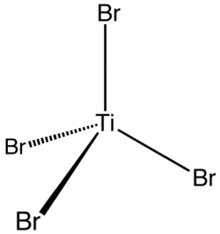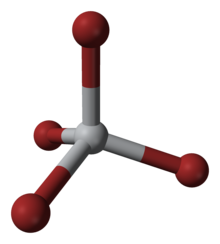This is an old revision of this page, as edited by Thricecube (talk | contribs) at 23:31, 28 May 2009. The present address (URL) is a permanent link to this revision, which may differ significantly from the current revision.
Revision as of 23:31, 28 May 2009 by Thricecube (talk | contribs)(diff) ← Previous revision | Latest revision (diff) | Newer revision → (diff)
| |

| |
| Names | |
|---|---|
| IUPAC name Titanium tetrabromide | |
| Other names Titanium(IV) bromide | |
| Identifiers | |
| CAS Number | |
| ECHA InfoCard | 100.029.259 |
| PubChem CID | |
| CompTox Dashboard (EPA) | |
| Properties | |
| Chemical formula | TiBr4 |
| Molar mass | 367.48 g/mol |
| Appearance | brown crystals hygroscopic |
| Density | 3.25 g/cm |
| Melting point | 39 °C |
| Boiling point | 230 °C |
| Solubility in water | decomposition |
| Solubility in other solvents | chlorocarbons, benzene |
| Structure | |
| Crystal structure | cubic, Pa3, Z = 8 |
| Coordination geometry | Tetrahedral |
| Dipole moment | 0 D |
| Hazards | |
| Occupational safety and health (OHS/OSH): | |
| Main hazards | corrosive |
| NFPA 704 (fire diamond) |
 |
| Flash point | nonflammable |
| Related compounds | |
| Other anions | TiCl4 TiI4 |
| Other cations | VCl4 |
| Except where otherwise noted, data are given for materials in their standard state (at 25 °C , 100 kPa). Infobox references | |
Titanium tetrabromide is the chemical compound with the formula TiBr4. It is the most volatile transition metal bromide. The properties of TiBr4 are an average of TiCl4 and TiI4. Some key properties of these four-coordinated Ti(IV) species are their high Lewis acidity and their high solubility in nonpolar organic solvents. TiBr4 is diamagnetic, reflecting the d configuration of the metal centre.
Preparation and structure
This four-coordinated complex adopts a tetrahedral geometry. It can be prepared via several methods: (i) from the elements, (ii) via the reaction of TiO2 with carbon and bromine (see Kroll process), and (iii) by treatment of TiCl4 with HBr.
Reactions
TiBr4 forms adducts such as TiBr4(THF)2 and . With bulky donor ligands, such as 2-methylpyridine (2-Mepy), five-coordinated adducts form. TiBr4(2-MePy) is trigonal bipyramidal with the pyridine in the equatorial plane.
TiBr4 has been used as a Lewis-acid catalyst in organic synthesis.
TiBr4 reacts rapidly with TiCl4 to give a statistical mixture of the tetrahalides, TiBr4-xClx (x = 0-4). The mechanism of this exchange is a matter of some dispute; a reasonable pathway involves the intermediacy of dimers.
Safety
TiBr4 hydrolyzes rapidly, potentially dangerously, to release hydrogen bromide.
References
- Holleman, A. F.; Wiberg, E. "Inorganic Chemistry" Academic Press: San Diego, 2001. ISBN 0-12-352651-5.
- Colin S. Creaser and J. Alan Creighton (1975). "Pentachloro- and pentabromo-titanate(IV) ions". J. Chem. Soc., Dalton Trans.: 1402–1405. doi:10.1039/DT9750001402.
- Hensen, K.; Lemke, A.; Bolte, M. (2000). "Tetrabromo(2-methylpyridine-N)-titanate(IV)". Acta Crystallographica. C56: e565 – e566. doi:10.1107/S0108270100015407.
{{cite journal}}: CS1 maint: multiple names: authors list (link) - B. Patterson, S. Marumoto and S. D. Rychnovsky (2003). "Titanium(IV)-Promoted Mukaiyama Aldol-Prins Cyclizations". Org. Lett. 5 (17): 3163–3166. doi:10.1021/ol035303n.
- S. P. Webb and M. S. Gordon (1999). "Intermolecular Self-Interactions of the Titanium Tetrahalides TiX4 (X = F, Cl, Br)". J. Am. Chem. Soc. 121 (11): 2552–2560. doi:10.1021/ja983339i.
| Titanium compounds | |||||
|---|---|---|---|---|---|
| Titanium(II) |
| ||||
| Titanium(III) |
| ||||
| Titanium(IV) |
| ||||